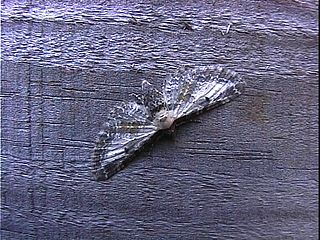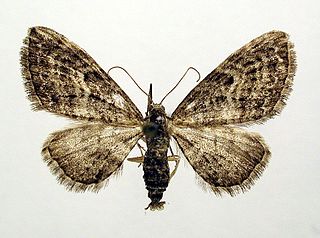
The slender pug is a moth of the family Geometridae. It was first described by Jacob Hübner in 1813 and is found throughout Europe and western parts of the Palearctic. The larva feeds on the catkins of willow.

The grey pug is a moth of the family Geometridae. It is found throughout the Palearctic region. It is also found in North America. Since it does not place any special demands on climatic conditions, special caterpillar food plants, geological subsoil or the like it is a typical species of almost any Hochstaudenflur, where it occurs in the herb layer, in bushes and even on deciduous trees. It can be found on forest edges and hedgerows, on heath, in rocky places and wetlands, parks and gardens, as well as in villages and town centres.

The bordered pug is a moth of the family Geometridae. It is found across the Palearctic region. In the Pyrenees, the species can be found up to an altitude of 1800 metres. It prefers steppe areas, open bushy terrain, fallow and unimproved grasslands and parkland.

The goldenrod pug is a moth of the family Geometridae. The species was first described by Henry Doubleday in 1861. It is found throughout the Palearctic region. In the British Isles it is widespread but rather locally distributed.

The juniper pug or juniper looper is a moth of the family Geometridae. The species was first described by Michael Denis and Ignaz Schiffermüller in 1775. It is found throughout the Palearctic and in the Nearctic.

The larch pug is a moth of the family Geometridae. The species can be found in Europe, the Ural Mountains, West and Central Siberia, the Altai Mountains, Transbaikalia, Yakutia, the Far East, Mongolia, Korea, Japan and in North America, from Yukon and Newfoundland to New York and Arizona.

Eupithecia simpliciata, the plain pug, is a moth of the family Geometridae. It is found in the Palearctic realm, from western Europe to north-western China (Xinjiang). The species primarily colonizes wastelands, rubble and abandoned vineyards, and in Asia also salt steppes. In the Alps, the range of altitude extends up to 1200 metres.

Eupithecia valerianata, the valerian pug, is a moth of the family Geometridae. The species was first described by Jacob Hübner in 1813. It is found from Great Britain, through central Europe to western Russia, Belarus and northern Iran.

Eupithecia distinctaria, the thyme pug, is a moth of the family Geometridae. It is found throughout Europe. It is also found in Iran. from the Iberian Peninsula through western and central Europe including the British Isles as well as further east as far east as far as Russia and Iran. In the north the range reaches as far as the southern Fennoscandia, to the south, where it is more common, it occupies the Mediterranean and Asia Minor. It is found primarily on warm, stony slopes and rocky structures as well as on sparse grassy areas with thyme mounds. In the Alps, it rises to heights of 2000 metres.
Eupithecia tropicata is a moth in the family Geometridae that is endemic to Thailand.
Eupithecia stueningi is a moth in the family Geometridae that is endemic to Thailand.
Eupithecia phantastica is a moth in the family Geometridae. It is found in Zhejiang in China and in Taiwan.
Eupithecia julia is a moth in the family Geometridae. It is found in western China (Sichuan).
Eupithecia phaea is a moth in the family Geometridae. It is found in Mongolia.
Eupithecia seatacama is a moth in the family Geometridae first described by Rindge in 1987. It is found in the regions of Atacama and Valparaiso in Chile. The habitat consists of either the Coquimban Desert or Central Coastal Cordillera Biotic Province.
Eupithecia semilotaria is a moth in the family Geometridae. It is found in southern Chile.
Eupithecia achyrdaghica is a moth in the family Geometridae first described by Eugen Wehrli in 1929. It is found in Turkey and Syria.
Eupithecia sticticata is a moth in the family Geometridae. It is found in Peru.
Eupithecia sylpharia is a moth in the family Geometridae. It is found in Brazil.
Eupithecia trigenuata is a moth in the family Geometridae. It is found in Peru.








